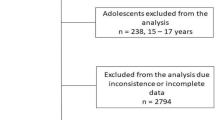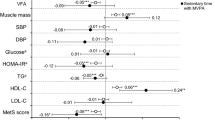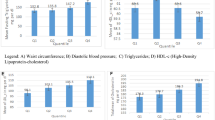Abstract
Previous studies suggest sedentary behavior (SB) is a risk factor for hypertension. However, buddhist activities related to SB in Tibetan monks is quite different from common SB. Meditation, chanting, and buddhist teaching are the main features during sitting. There is no study to examine the association between buddhist activities related to sitting and hypertension. There were 594 Tibetan monks included for analysis. Buddhist activities related to SB involve hours of meditation, chanting, and buddhist teaching for a typical weekday and weekend day. After controlling potential risk factors, compared with Tibetan monks who has the sedentary time < 8 h/d, those with 10 h/d ≤ sedentary time < 11 h/d was associated with about 80% decrease in the risk of hypertension (OR = 0.22;95% CI = 0.07–0.71), and about 90% decrease (OR = 0.11; 95% CI = 0.03–0.40) in those with sedentary time ≥ 11 h/d. In hypertension subgroup, buddhist activities related to SB is associated with a decrease in BP during linear regression analysis (standard β = -0.355; P = 0.004 for SBP; standard β = −0.345; P = 0.013 for DBP). We conclude that sitting might not simply represent the extremely low energy expenditure of the physical activity continuum. Psychosocial activities may play an important role in SB.
This is a preview of subscription content, access via your institution
Access options
Subscribe to this journal
Receive 12 digital issues and online access to articles
$119.00 per year
only $9.92 per issue
Buy this article
- Purchase on Springer Link
- Instant access to full article PDF
Prices may be subject to local taxes which are calculated during checkout
Similar content being viewed by others
References
Chomistek AK, Manson JE, Stefanick ML, Lu B, Sands-Lincoln M, Going SB, et al. Relationship of sedentary behavior and physical activity to incident cardiovascular disease: results from the Women’s Health Initiative. J Am CollCardiol. 2013;61:2346–54.
Wirth K, Klenk J, Brefka S, Dallmeier D, Faehling K, Roqué I, Figuls M, et al. Biomarkers associated with sedentary behaviour in older adults: a systematic review. Ageing Res Rev. 2017;35:87–111.
Dunstan DW, Barr EL, Healy GN, Salmon J, Shaw JE, Balkau B, et al. Television viewing time and mortality: The Australian Diabetes, Obesity and Lifestyle Study (AusDiab). Circulation. 2010;121:384–91.
Bankoski A, Harris TB, McClain JJ, Brychta RJ, Caserotti P, Chen KY, et al. Sedentary activity associated with metabolic syndrome independent of physical activity. Diabetes Care. 2011;34:497–503.
Ahmad S, Shanmugasegaram S, Walker KL, Prince SA. Examining sedentary time as a risk factor for cardiometabolic diseases and their markers in South Asian adults: a systematic review. Int J Public Health. 2017;62:503–15.
Beunza JJ, Martínez-González MA, Ebrahim S, Bes-Rastrollo M, Núñez J, Martínez JA, et al. Sedentary behaviors and the risk of incident hypertension: the SUN Cohort. Am J Hypertens. 2007;20:1156–62.
Sohn MW, Manheim LM, Chang RW, Greenland P, Hochberg MC, Nevitt MC, et al. Sedentary behavior and blood pressure control among osteoarthritis initiative participants. Osteoarthr Cartil. 2014;22:1234–40.
Ford ES, Li C, Zhao G, Pearson WS, Tsai J, Churilla JR. Sedentary behavior, physical activity, and concentrations of insulin among US adults. Metabolism. 2010;59:1268–75.
Meles E, Giannattasio C, Failla M, Gentile G, Capra A, Mancia G. Nonpharmacologic treatment of hypertension by respiratory exercise in the home setting. Am J Hypertens. 2004;17:370–4.
Ferraro KF, Kim S. Health benefits of religion among Black and White older adults? Race, religiosity, and C-reactive protein. SocSci Med. 2014;120:92–9.
Kretchy I, Owusu-Daaku F, Danquah S. Spiritual and religious beliefs: do they matter in the medication adherence behaviour of hypertensive patients? Biopsychosoc Med. 2013;7:15.
Buck AC, Williams DR, Musick MA, Sternthal MJ. An examination of the relationship between multiple dimensions of religiosity, blood pressure, and hypertension. Soc Sci Med. 2009;68:314–22.
Bell CN, Bowie JV, Thorpe RJ Jr. The interrelationship between hypertension and blood pressure, attendance at religious services, and race/ethnicity. J Relig Health. 2012;51:310–22.
Liu J, Hong Y, D’Agostino RB Sr, Wu Z, Wang W, Sun J, et al. Predictive value for the Chinese population of the Framingham CHD risk assessment tool compared with the Chinese Multi-Provincial Cohort Study. JAMA. 2004;291:2591–9.
Ren J, Grundy SM, Liu J, Wang W, Wang M, Sun J, et al. Long-term coronary heart disease risk associated with very-low-density lipoprotein cholesterol in Chinese: the results of a 15-Year Chinese Multi-Provincial Cohort Study (CMCS). Atherosclerosis. 2010;211:327–32.
Liu K, Wang Y, He J, He S, Liao H, Si D, et al. Is pulse pressure a predictor of diabetes in Chinese Han nationality population? 15-year prospective study in Chengdu community. Int J Cardiol. 2014;176:529–32.
He S, Shu Y, He J, Chen X, Cui K, Feng J, et al. The effects of initial and subsequent adiposity status on diabetes mellitus. Int J Cardiol. 2013;168:511–4.
Hardy LL, Denney-Wilson E, Thrift AP, Okely AD, Baur LA. Screen time and metabolic risk factors among adolescents. Arch Pediatra Med. 2010;164:643–9.
Pedersen BK, Febbraio MA. Muscles, exercise and obesity: skeletal muscle as a secretory organ. Nat Rev Endocrinol. 2012;8:457–65.
de Moraes AC, Carvalho HB, Siani A, Barba G, Veidebaum T, Tornaritis M, et al. Incidence of high blood pressure in children-effects of physical activity and sedentary behaviors: the IDEFICS study: high blood pressure, lifestyle and children. Int J Cardiol. 2015;180:165–70.
Dusek JA, Hibberd PL, Buczynski B, Chang BH, Dusek KC, Johnston JM, et al. Stress management versus lifestyle modification on systolic hypertension and medication elimination: a randomized trial. J Altern Complement Med. 2008;14:129–38.
Bhasin MK, Dusek JA, Chang BH, Joseph MG, Denninger JW, Fricchione GL, et al. Relaxation response induces temporal transcriptome changes in energy metabolism, insulin secretion and inflammatory pathways. PLoS ONE. 2013;8:e62817.
Cramer H, Lauche R, Haller H, Steckhan N, Michalsen A, Dobos G. Effects of yoga on cardiovascular disease risk factors: a systematic review and meta-analysis. Int J Cardiol. 2014;173:170–83.
Pengpid S, Peltzer K, Skaal L. Efficacy of a church-based lifestyle intervention programme to control high normal blood pressure and/or high normal blood glucose in church members: a randomized controlled trial in Pretoria, South Africa. BMC Public Health. 2014;14:568.
Salim I, Al Suwaidi J, Ghadban W, Alkilani H, Salam AM. Impact of religious Ramadan fasting on cardiovascular disease: a systematic review of the literature. Curr Med Res Opin. 2013;29:343–54.
Khafaji HA, Bener A, Osman M, Al Merri A, Al Suwaidi J. The impact of diurnal fasting during Ramadan on the lipid profile hsCRP and serum leptin in stable cardiac patients. Vasc Health Risk Manag. 2012;8:7–14.
Hoogerwaard AF, de Jong MR, Elvan A. Renal nerve stimulation as procedural end point for renal sympathetic denervation. Curr Hypertens Rep. 2018;20:24.
Grassi G, Seravalle G, Bertinieri G, Turri C, Dell’Oro R, Stella ML, et al. Sympathetic and reflex alterations in systo-diastolic and systolic hypertension of the elderly. J Hypertens. 2000;18:587–93.
Grassi G, Mark A, Esler M. The sympathetic nervous system alterations in human hypertension. Circ Res. 2015;116:976–90.
Hagins M, Rundle A, Consedine NS, Khalsa SB. A randomized controlled trial comparing the effects of yoga with an active control on ambulatory blood pressure in individuals with prehypertension and stage 1 hypertension. J ClinHypertens (Greenwich). 2014;16:54–62.
Suboc TB, Knabel D, Strath SJ, Dharmashankar K, Coulliard A, Malik M, et al. Associations of reducing sedentary time with vascular function and insulin sensitivity in older sedentary adults. Am J Hypertens. 2016;29:46–53.
Charlemagne-Badal SJ, Lee JW. Intrinsic religiosity and hypertension among older North American seventh-day adventists. J Relig Health. 2016;55:695–708.
Kobayashi D, Shimbo T, Takahashi O, Davis RB, Wee CC. The relationship between religiosity and cardiovascular risk factors in Japan: a large-scale cohort study. J Am Soc Hypertens. 2015;9:553–62.
Xu S, Jiayong Z, Li B, Zhu H, Chang H, Shi W, Gao Z, et al. Prevalence and clustering of cardiovascular disease risk factors among Tibetan adults in China: A Population-Based Study. PLoS ONE. 2015;10:e0129966.
Acknowledgements
We thank Dr. qian’s team at Ganzi Tibetan Autonomous Prefecture People’s Hospital in Sichuan Province of China, for their contributions to this study.
Funding
This study was supported by two projects from the Science & Technology Pillar Program in Sichuan Province, China (grant no: 2012SZ0131and 17ZDYF3050).
Author information
Authors and Affiliations
Corresponding author
Ethics declarations
Conflict of interest
The authors declare that they have no conflict of interest.
Electronic supplementary material
Rights and permissions
About this article
Cite this article
Liu, K., Xu, Y., Wang, S. et al. Buddhist Activities related to Sedentary behavior and Hypertension in Tibetan monks. J Hum Hypertens 33, 756–762 (2019). https://doi.org/10.1038/s41371-018-0136-0
Received:
Revised:
Accepted:
Published:
Issue Date:
DOI: https://doi.org/10.1038/s41371-018-0136-0



